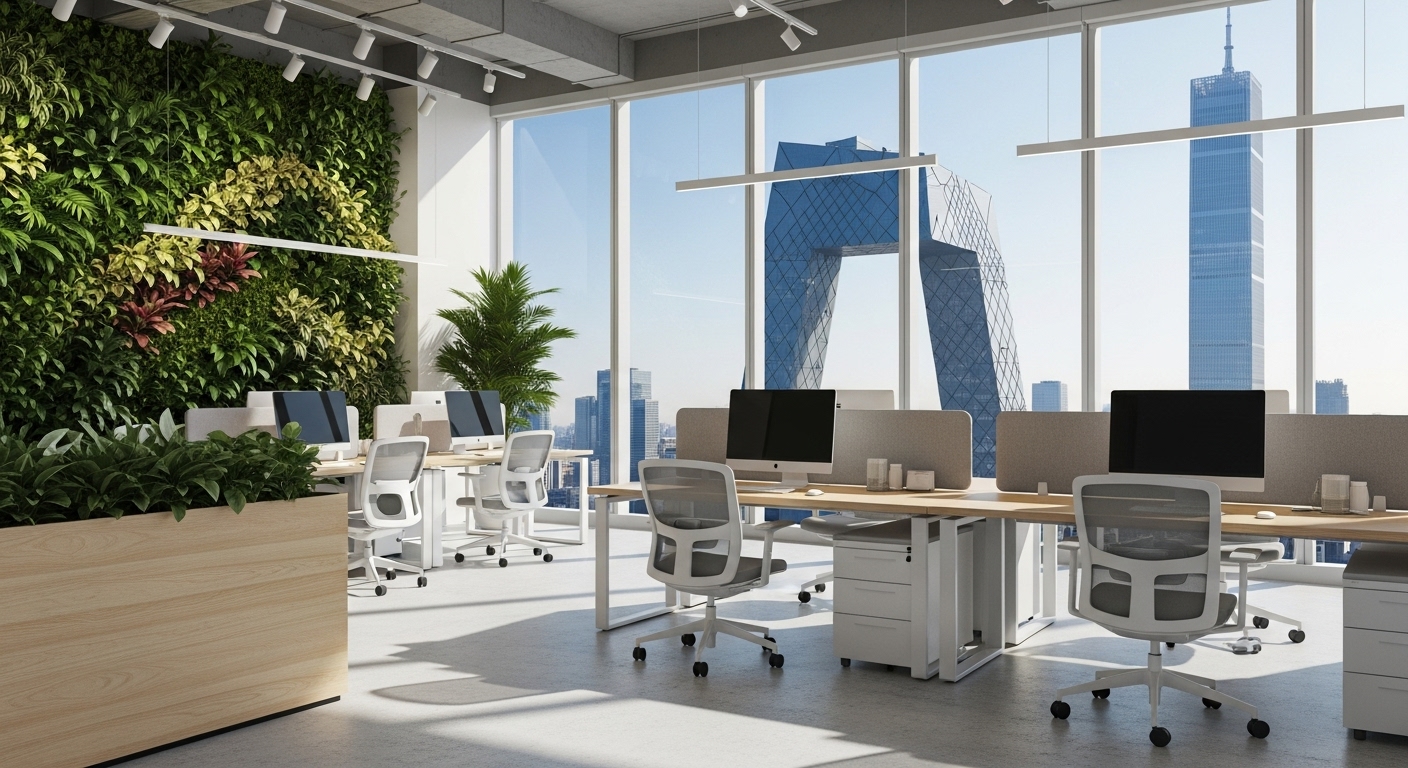In today’s dynamic business environment, the concept of the ‘office’ has fundamentally transformed. It’s no longer just a physical location for employees to clock in and out; it’s a strategic asset that can accelerate growth, define company culture, and act as a magnet for top talent. The post-pandemic world has shattered the one-size-fits-all model, forcing founders and leaders to reconsider what a workspace truly represents. Choosing your space is now a critical business decision, as impactful as developing a product or securing funding. This playbook moves beyond simple cost-per-square-foot calculations to provide a strategic framework for selecting a workspace that actively drives success. We will explore how to conduct a deep analysis of your operational needs, navigate the expanding spectrum of modern workspace solutions, and align your physical environment with your company’s most important goals—from financial resilience to a thriving, collaborative culture.
1. Beyond Square Footage: Defining Your Core Workspace Needs
Before you even begin looking at listings, the most critical step is an internal audit of your company’s unique needs. This process goes far beyond a simple headcount. The first question to ask is about your team’s work style. Are you a highly collaborative organization that thrives on spontaneous brainstorming, or does your team require deep, focused concentration? The ideal space for a creative agency is vastly different from that of a software development firm. Consider mapping out typical workflows and identifying the primary modes of work: collaborative, focused, social, and learning. A successful workspace provides distinct zones that cater to each of these activities. Secondly, your workspace is a physical embodiment of your brand and culture. It sends a powerful message to employees, clients, and potential investors. What story do you want your office to tell? Should it convey innovation and cutting-edge design, or stability and tradition? This ‘brand feel’ should influence everything from the building’s architecture to the interior decor. Finally, align your workspace needs with your strategic business objectives. If you’re planning rapid scaling, you need a solution that can grow with you. If your goal is to attract a specific talent demographic, your location and amenities must appeal to them. Documenting these core needs—work style, brand identity, and strategic goals—creates a foundational scorecard against which you can measure every potential option.
2. Navigating the Modern Workspace Spectrum
The market for office space is more diverse than ever, offering a spectrum of solutions tailored to different business models and stages of growth. Understanding the nuances of each option is key to making an informed decision. At one end is the traditional lease, a long-term commitment (often 5-10 years) that offers maximum control over branding, layout, and security. While it provides stability and can be cost-effective at scale, it comes with significant upfront capital expenditure for fit-outs and a lack of flexibility that can be risky for a growing company. Next are serviced offices, which provide fully furnished, move-in-ready spaces with all-inclusive amenities like reception services, utilities, and IT support. This model, often with shorter terms of 1-3 years, reduces initial costs and management overhead. However, it offers less opportunity for custom branding and can be more expensive per square foot over the long term. Coworking spaces represent the most flexible end of the spectrum, offering everything from single hot desks to private offices on a month-to-month basis. They foster a sense of community and provide valuable networking opportunities, but can also present challenges with noise, privacy, and maintaining a distinct company culture. Finally, many companies are adopting a hybrid or portfolio approach, combining a central ‘hub’ office for collaboration with flexible passes to coworking spaces near employees’ homes. This ‘Hub-and-Spoke’ model can optimize costs while offering the ultimate flexibility and talent attraction advantage.
3. The Financial Equation: Balancing Budget with Long-Term Value
A strategic workspace decision requires looking beyond the base rent to understand the Total Cost of Occupancy (TCO). For a traditional lease, the advertised price is just the beginning. You must factor in significant additional expenses: fit-out and construction costs, furniture, IT infrastructure setup, security deposits, property taxes, common area maintenance (CAM) fees, utilities, and ongoing facility management. These costs represent a substantial capital expenditure (CapEx) that can strain the cash flow of a growing business. In contrast, flexible options like serviced offices and coworking spaces operate on an operational expenditure (OpEx) model. The monthly fee is typically all-inclusive, bundling rent, utilities, internet, cleaning, and amenities into a single, predictable payment. This dramatically lowers the upfront investment and simplifies budgeting. When comparing options, it’s crucial to build a comprehensive TCO model for each scenario over a 3-5 year period. As commercial real estate advisor Michael Silver of Vestian stated,
“An effective real estate strategy is not about finding the cheapest space, but the one that provides the best value and supports the business’s overall objectives.”
This means weighing the raw cost against intangible benefits. Does a higher-cost, amenity-rich space improve employee retention and productivity? Does a flexible term de-risk your business against future uncertainty? The smartest financial decision is the one that provides the greatest strategic value, not just the lowest monthly rent.
4. Culture and Collaboration: Designing for Human Interaction
Your workspace is the physical stage where your company culture plays out daily. A poorly chosen environment can create friction and disengagement, while a well-designed one can act as a powerful catalyst for collaboration and innovation. The layout itself is a critical factor. The era of endless open-plan offices is giving way to more nuanced designs that balance collaborative zones with private areas for focused work. A strategic layout includes a variety of spaces: open ‘plazas’ for informal gatherings, bookable meeting rooms with robust video conferencing capabilities, quiet pods for individual calls, and comfortable social areas like kitchens and lounges. These ‘in-between’ spaces are often where the most valuable spontaneous interactions occur. Furthermore, the amenities you offer speak volumes about your values. Investing in employee well-being through features like natural light, ergonomic furniture, wellness rooms, and healthy snack options demonstrates a commitment that goes beyond the bottom line. This focus on the human experience is essential for attracting and retaining top talent in a competitive market. Ultimately, your space should encourage the specific behaviors you want to foster. If innovation is a core value, create dedicated project rooms with whiteboards and prototyping tools. If transparency is key, use glass walls and open sightlines. The right workspace doesn’t just house your team; it actively helps shape a positive, productive, and resilient culture.
5. The Technology Layer: Ensuring Seamless Connectivity and Security
In the modern digital-first workplace, technology infrastructure is not an afterthought—it’s the central nervous system of your operation. A workspace decision cannot be separated from a thorough tech audit. The absolute baseline requirement is reliable, high-speed, enterprise-grade internet with built-in redundancy. For any company, and especially for tech-focused businesses, slow or unstable connectivity is a non-starter that directly impacts productivity and revenue. Beyond bandwidth, robust physical and cybersecurity is paramount. This includes secure access control systems (like keycards or mobile access), surveillance, and a secure, segregated network to protect sensitive company data, particularly in a multi-tenant environment. For hybrid teams, the quality of meeting room technology is a make-or-break factor for effective collaboration. Rooms must be equipped with high-quality cameras, microphones, and displays that create an equitable experience for both in-person and remote participants. A forward-thinking approach also considers ‘smart building’ features. These can include integrated room-booking systems, sensors that provide data on space utilization to help optimize your footprint, and app-based controls for lighting and climate. Evaluating a potential space must involve your IT leader to ensure the building’s infrastructure can meet not only your current needs but also your future technological ambitions. Failing to vet the technology layer is a recipe for daily frustration and long-term operational inefficiency.
6. Location Intelligence: More Than Just a Prestigious Address
The adage ‘location, location, location’ remains true, but the definition of a ‘good’ location has evolved. While a prestigious address can enhance brand perception, a truly strategic location is chosen based on data-driven intelligence centered on your people and clients. The primary consideration should be your talent pool. Where do your current and desired employees live? Analyzing commute times is critical; a difficult commute is a major source of employee dissatisfaction and a barrier to attracting new talent. A location with excellent access to public transportation, major highways, and perhaps even cycling lanes is a significant asset. Next, consider the local ecosystem. What amenities are within walking distance? Proximity to cafes, restaurants, fitness centers, and childcare facilities enhances the employee experience and makes your office a more attractive destination. The character of the neighborhood should also align with your company culture. A vibrant, creative district may be perfect for a media company, while a financial firm might benefit from being in the central business district. Finally, evaluate proximity to your key clients, partners, and industry hubs. Being physically close to your business ecosystem can facilitate stronger relationships and uncover new opportunities. Using mapping tools and demographic data to analyze these factors—talent accessibility, local amenities, and business ecosystem—ensures your location is a strategic advantage, not just a line on your letterhead.
7. Future-Proofing Your Footprint: Building in Flexibility and Scalability
The one certainty in business is change. Your company will grow, team structures will shift, and market dynamics will evolve. The greatest risk in any workspace decision is being locked into a rigid solution that cannot adapt to your future needs. Therefore, future-proofing your choice by prioritizing flexibility and scalability is essential. For startups and high-growth companies, this often means avoiding long-term, traditional leases in the early stages. Opting for a serviced office or coworking provider with a large network can be a powerful strategy. This allows you to easily add more desks or move to a larger private office within the same building or portfolio, minimizing disruption. When you do consider a lease, negotiate terms that build in flexibility. This could include rights of first refusal on adjacent spaces, clauses allowing you to sublet a portion of your office, or shorter lease terms with options to renew. The concept of a ‘workspace portfolio’ is another key future-proofing strategy. Instead of committing to one large central headquarters, you might have a smaller core office for key collaborative tasks, supplemented by memberships at coworking spaces in different locations to accommodate a distributed team. This approach provides financial and operational agility, allowing you to scale your real estate footprint up or down in response to business needs without being constrained by a single, monolithic lease. Ultimately, the goal is to view your workspace not as a fixed cost, but as a dynamic asset that can be optimized over time.
Choosing your workspace is one of the most significant strategic decisions a founder will make. It’s a complex process that demands a holistic view, moving far beyond a simple real estate transaction. As we’ve explored, the right choice is found at the intersection of your company’s unique operational needs, financial realities, cultural aspirations, and long-term growth strategy. By beginning with a deep internal audit of your work styles and brand, you create a clear vision. By thoroughly evaluating the entire spectrum of modern workspace options—from traditional leases to hyper-flexible hubs—you can match a solution to your specific stage of development. The decision requires a sophisticated financial analysis that considers the total cost of occupancy and weighs it against strategic value, ensuring your budget supports, rather than constrains, your goals. The ultimate aim is to select a space that is more than just a container for work. A strategic workspace is an active partner in your success. It enhances collaboration, strengthens your culture, attracts and retains the best people, and provides the flexibility to navigate future challenges and opportunities. By following this playbook, you can transform your physical footprint from a mere expense into a powerful engine for innovation and growth.





